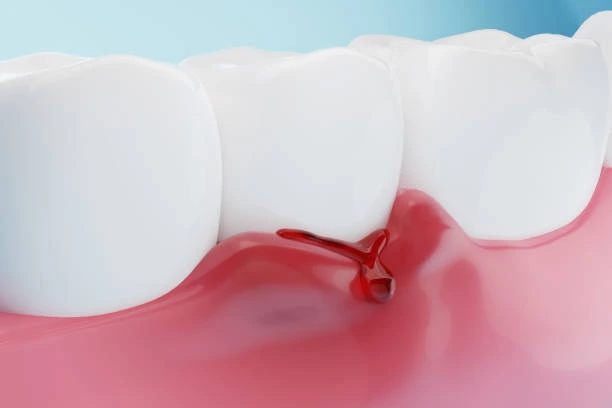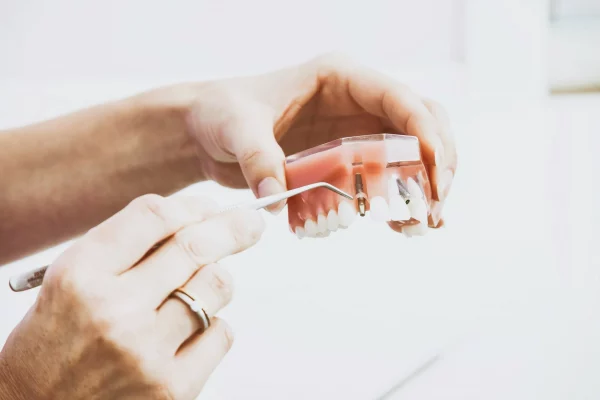You may be surprised to know that dental implants can be a life changing experience to those who have lost their teeth as a result of gum disease- it does not only restore your smile, but also your confidence and quality of life. Your dentist will have to make sure that your gums and jawbone are healthy to support the procedure before proceeding with it, however.
This blog will take you through all the steps, including post-gum disease assessment, advanced implant procedures and long-term maintenance plans. Through proper nurture and professional planning, you can reconstruct your smile, and maintain it sturdy in the years to come.
How Gum Disease Affects Dental Implant Eligibility

Having gum disease should not necessarily exclude you as a candidate to receive dental implants, but it should bring up a few concerns. The success of implants relies on healthy gums and strong jawbone support and both may be affected by active infection. The initial step is an understanding of the effect of previous or current periodontal concerns on candidacy and assuring a safe and successful result.
Bone Loss from Periodontitis and Implant Stability
Due to advanced periodontal disease, there is a tendency to destroy jawbones that support teeth, known as alveolar bone. Dental implants are based on a phenomenon known as osseointegration, which means that the implant is bonded with the bone, thus the insufficient bone affects the stability and durability of the implants.
Your dentist will take imaging (X-ray, panoramic X-rays, or CBCT) to assess the bone height, width, and quality to establish eligibility. In case the bone has been extensively resorbed as a result of infection, it could take a long time before implants can be placed or there may be need to do more grafting.
When Gum Disease Must Be Treated First
The primary red flag is active gum infection when it comes to dental implants. The inflammation may persist, and this may inhibit the implant and the bone to bond properly and heal. Your dentist will be required to cure the gum disease in order to have a long term success. This can involve extensive cleaning such as scaling and root planning, antibiotic treatment or even surgery in severe cases. Making the gums stable and getting rid of infection provides a healthier base to place the implants. Implant treatment can only proceed safely after your gums have been made infection-free.
Chronic Inflammation and Its Impact on Healing
The inflammation of gums that occurs frequently can cause the secretion of inflammatory compounds such as IL-6 and TNF-alpha which may disrupt the natural healing process in your body. These drugs affect bone healing and compromise the immune system two important parameters in the successful integration of dental implants. Once these conditions prevail, chances of implant failure increase tremendously. Peri-implantitis, which is an infection that destroys the tissues around an implant, is one of the major concerns. It may result into loss of bone and instability unless corrected early. To minimize these risks and encourage long-term success, it is necessary to maintain the health of the gums prior to implant surgery.
Assessing Candidacy for Implants After Gum Issues

It is not a case that all those who have gum disease history are not disqualified to receive a dental implant. The requirement of your candidacy is based on a number of factors such as the degree of previous damage, the health of the gums at present, and the amount of bone. A comprehensive examination including digital imaging and periodontal analysis assist your dentist in deciding whether your mouth is able to hold implants permanently.
In case of need, such procedures as bone grafting or gum therapy may be conducted to make your jaw ready to become successful in implants. The aim is to establish a stable infection-free environment which will allow your new smile the best opportunity to succeed. Numerous patients with a history of gum problems end up having robust, permanent dental implants with proper treatment regimen.
What Dentists Look for in Post-Periodontal Patients
Your implant provider will measure various key factors after your mouth has healed following periodontal therapy in order to determine your candidacy. One, your gums should be healthy; that is, they should not be red and swollen and bleeding which means that the infection is in check. There must also be sufficient bone quantity; usually 3-5 mm of solid bone is required around the implant site to give long-term stability. Your adherence to healthy oral hygiene and dental visits is very crucial when it comes to the health of the implants.
Also, there should be no underlying medical conditions that cannot be controlled well with complications like diabetes. When all these are concurring, you stand a better chance of being a good candidate to have the dental implants even after gum disease.
Bone Grafting as a Solution for Lost Jawbone
In case the imaging shows that there is not enough bone, your dentist might suggest a bone graft to create a solid support to the implant. The grafts can be autografts (your bone, usually jaw or hip); allografts (human donor); xenografts (animal, e.g. cow bone); and alloplasts (synthetic). Both of them are used to replace the volume lost and to increase the density of the bone, and this makes the perfect setting in which the implant can become bonded to the jawbone, a process known as osseointegration. The time to heal is different, with majority of patients healing between 3 to 6 months after which implants can be successfully and safely introduced.
Health Requirements for Successful Osseointegration
In order to proceed with dental implants following gum disease, you will have to exhibit clear evidence of gum stability, in other words, no pockets should be more than 4 mm deep and there should be no bleeding on probing. Moreover, your jawbone should be very dense and strong enough to support the anchor of the implant. Lifestyle factors are also important. It is necessary to avoid tobacco, maintain a healthy diet and treat chronic illnesses such as diabetes. This multi-step assessment procedure is aimed at making your implants as successful and stable as possible.
Advanced Implant Techniques for Compromised Gums
Gum disease does not necessarily spell the end of your dream of a confident functional smile. With the current advanced dental procedures, patients have a chance of getting implants despite their past or current gum problems. These new solutions are made in order to counteract such issues as bone loss and weak gum tissue, which will allow you to reclaim your smile and make it strong and stable.
All-on-4 and Zygomatic Implants for Severe Bone Loss
All-on-4 dental implants provide an innovative alternative to patients who have significant bone loss in that only 4 well-positioned implants are required to support a full-arch prosthesis, and in many cases do not require a bone graft. The technique makes it possible to heal faster and restore the smile faster.
In still more complicated cases, the zygomatic implants are placed into the cheekbone, avoiding weakened upper jaw bone and eliminating the necessity of sinus lifts. Both are game-changers with the promise of hope and permanent solutions to the people who were told that they could not have implants because of gum disease.
Using Smaller Implants for Minimal Invasive Surgery
Patients with small yet stable bone should use short or narrow diameter implants. These less-invasive implants occupy smaller spaces, and in many cases, they do not require grafts to be performed at all, and in some cases, they can be placed the same day, which is an attractive and comfortable way to restore your smile.
Custom Implant Planning with 3D Scans and CBCT
The 3D planning software changes the game when it comes to implant placement due to the precision that it brings. It assists your dentist in avoiding nerve, maximising angulation and simulating the end result position of the crown-both beautiful and functional. Using custom surgical guides made with this information, every implant will be inserted where it should be, and the chances of success will be increased, and the risks will be reduced.
Long-Term Care After Implants in Former Gum Disease Patients
Brushing, flossing and frequent cleanings (3-4 times a year) are essential. Do not smoke, eat right, and treat such conditions as diabetes. A nightguard could assist in the event that you grind your teeth. Implants are long lasting with the right care even following gum disease.
Preventing Peri-Implantitis Through Oral Hygiene
It is necessary to brush twice a day and floss once a day. Your provider may suggest special cleaning brushes or antimicrobial mouthwashes. Regular examinations help to treat minor problems in their early stages. Remaining dedicated to your home care practice guards your implants against future issues. Implants may last forever, as well, with proper care, even following gum disease.
Routine Checkups and Deep Cleanings
Set up plans after 3-4 months of the first year and 6 months. Special instruments are used in professional cleaning around the implant to prevent damage. Your dentist will be able to examine the health of the tissues and act in time in case the swelling appears.
Warning Signs That Require Immediate Attention
Pay attention to the redness, swelling, bleeding, loose implants, or bite changes as warning signs. Should they occur, report to your dentist as soon as possible, early intervention is the solution to the durability of implants. The neglect of symptoms may cause peri-implantitis that might demand complicated procedures or even the removal of the implants.
Frequently Asked Questions (FAQs)
1. Can I get implants if I had periodontitis in the past?
Yes, many people who’ve had gum disease can still qualify for dental implants, as long as the infection has been fully treated and the gums are healthy. Dentists will assess the bone structure to see if it’s strong enough to support implants. In cases of bone loss, a grafting procedure may be recommended to rebuild the foundation. With proper healing and care, implants can then be placed successfully. This process is carefully planned to ensure long-term comfort, stability, and a natural-looking smile. With today’s advancements, dental implants remain a reliable solution even after gum disease.
2. Will I need bone grafting before implant placement?
Possibly. If your dental scans show that your jawbone isn’t strong or thick enough, your provider may recommend a bone graft to create a solid foundation for your dental implants. While this might sound intimidating, it’s a common and safe step that supports long-term implant success. In some cases, advanced systems like All-on-4 implants can reduce or eliminate the need for grafting by strategically angling the implants into denser bone areas. Your dentist will personalize your treatment plan based on your unique needs, ensuring you’re comfortable and confident every step of the way.
3. Is gum disease likely to return after getting implants?
Gum disease can return if oral hygiene routines are neglected or regular dental visits are missed. However, with consistent care such as daily brushing and flossing, routine exams, and professional cleanings you can significantly reduce the risk of complications like peri-implantitis. Former gum disease patients who stay informed and proactive often enjoy long-term success with their dental implants. Commitment to maintenance is key to protecting both your implants and your overall oral health. With the right habits, healthy implants can last a lifetime.
4. How long should I wait after gum treatment to get implants?
Full gum healing typically takes about 3 to 6 months following periodontal treatment, depending on the severity of the disease and your body’s healing response. If bone grafting is part of your treatment, the timeline may extend to ensure proper bone integration. During this period, your dentist will monitor your progress through imaging and thorough clinical evaluations. Only when your gums and bone are stable and healthy will they move forward with dental implant placement. This careful approach ensures the best possible outcome and long-term implant success.
5. Do implants last as long in patients with gum disease history?
With proper supportive care, dental implants in patients who’ve had gum disease can last just as long as those in individuals with no history of periodontal issues. Success depends heavily on daily oral hygiene, regular dental check-ups, and professional cleanings. Preventing new infections is essential to protect the gums and bone around the implants. Your commitment to maintenance directly impacts the long-term health and stability of your smile.
If gum disease robbed you of your smile, and you’re ready to take it back, dental implants offer a reliable path to restoration. Whether through standard implants, All-on-4 systems, or zygomatic solutions, personalized care can offer comfort, confidence, and lasting function.
Schedule a consultation today to assess your bone health, explore suitable treatment options, and build a tailored plan that respects your history. It’s time to reclaim your smile and embrace the freedom that comes with strong, natural-looking dental implants.


